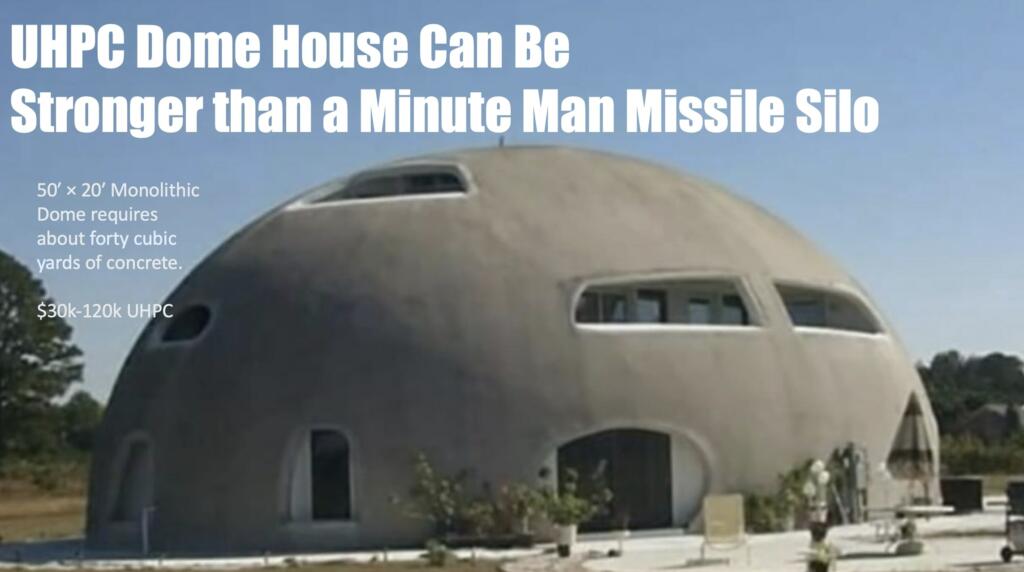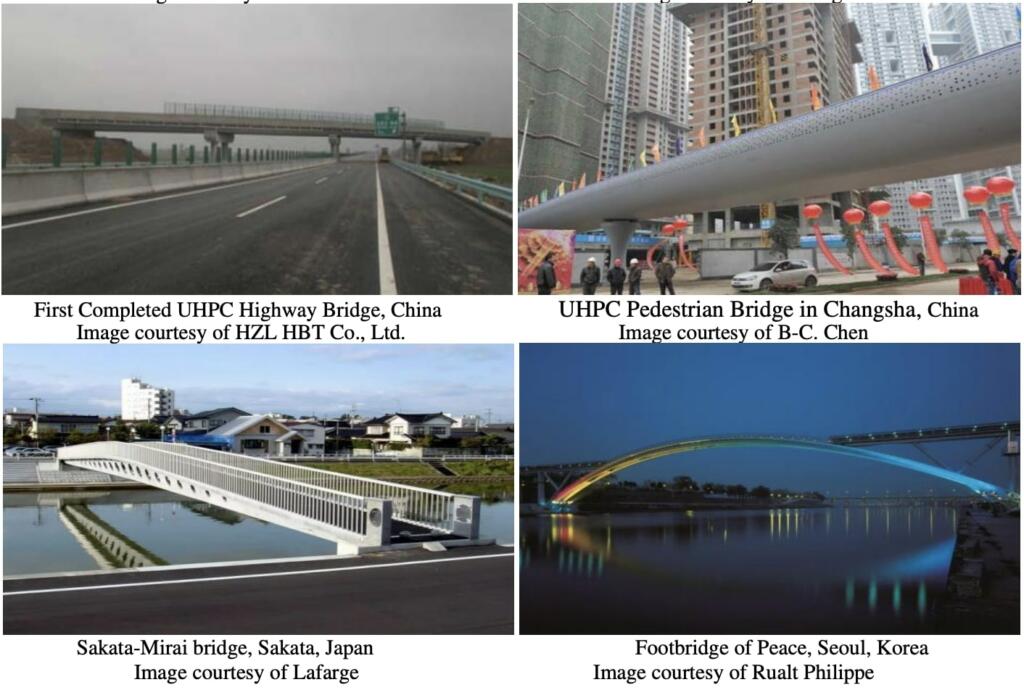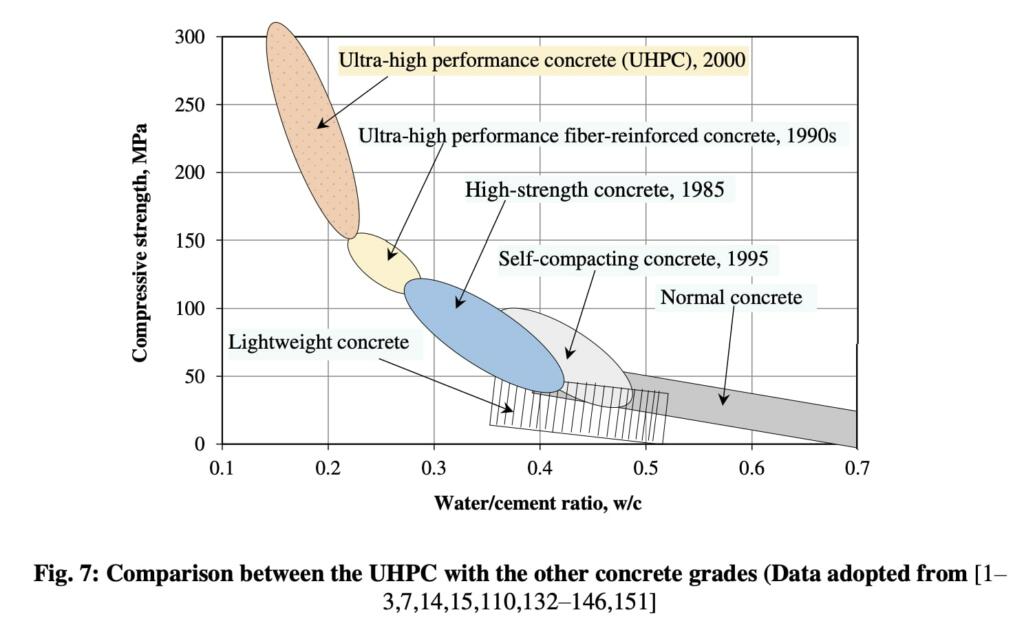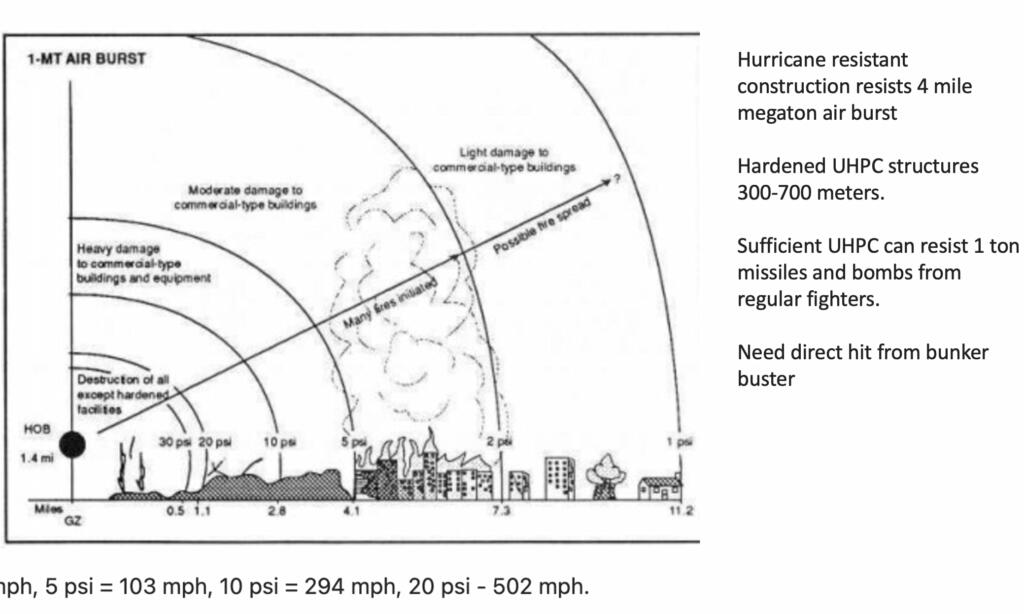Ultra-high performance concrete (UHPC) is an enhanced fibrous and cementitious concrete with high compressive strength (120–250 MPa) particle packing density (0.825–0.855, tensile strength (15–20 MPa) and extraordinary durability. UHPC has 300 times the ductility and energy absorption of high performance concrete (HPC) and three to sixteen times the compressive strength of regular concrete.
A $100+ billion US Air Force contract given to Northrop Grumman to upgrade US ICBMs also includes funds to build new missile silos. Old missile silos have outdated weaker concrete materials given the transformation of these materials over the last 20 years and the continuing developments. In 2024, the total program cost was estimated above $131 billion, could grow further as the U.S. Secretary of Defense concludes a review by the summer. Program changes, such as making bigger silos and switching to more durable materials, have also raised costs. The cost overrun is most acutely felt in modernizing the 450 missile silos and their command infrastructure, which includes 7,500 miles of new cables. The program will also buy trucks, training, command buildings and 659 missiles. The 70 year old Minute Man silos used 2000 PSI concrete. There are some US silos with 5000 PSI concrete. This is far below the 40,000 to 60,000 PSI state of the art materials. In 2010, there was 150,000 cubic yards of 10,000-14000 PSI concrete for the Freedom Tower in New York.
About $500 million of the billions spent on the Freedom Tower was the UHPC concrete. It has stronger material than the old Minute Man silos. The large amount of UHPC has moved it into the mainstream higher end option for skyscrapers, bridges and roads.

In total there were 1,000 Minuteman missiles deployed from the 1960’s into the early 1990’s. The launch facility consists of a silo 12 feet in diameter and 80 feet deep made of reinforced concrete with a steel-plate liner.
Russian silos are reportedly hardened to 15,000-25,000 pounds per square inch (psi). China has hundreds of new nuclear silo with ultra hard concrete.
The bomb can penetrate 200 feet of 5000 psi hardened concrete and is accurate enough for multiple hits on the same location to penetrate deeper targets or targets with even stronger concrete. One GBUJ-57A/B can only penetrate 8 meters (26 feet) of 10,000 psi rock or concrete. This could drop to 2 meters (6.5 feet) of 30,000 psi material. Rock of over 10,000 psi is considered hard. The strongest granite is about 30,000 psi. In 2007, the University of Tehran made several concrete cubes between 50,000 to 60,000 psi, and possible stronger.
Mark Zuckerberg is building an underground bunker. This is definitely using UHPC.

A dome house using UHPC would only need about 40 cubic meters of material for a highly bomb resistant structure. This only need $120,000 worth of UHPC material. IF the efforts to develop low-cost UHPC are successful then the cost of UHPC for such a building would drop to $30,000. The high strength material could replace larger amounts of regular concrete.

The high strength also allows interesting architectural choices with strong but thin elements.


akes it a perfect material for applications where strength is a primary design criterion and concrete structural element sizes can be lowered to make them smaller, thinner, and more aesthetically acceptable. It is commonly composed of Portland cement, fine aggregate, SF, a waterreducing additive with a high range of effectiveness, and fibers.
According to the concrete’s market survey, the global UHPC market size was estimated at $892 million in 2016 and is projected to increase by 8.6% to $1,870 million by 2025.
There is currently a trend to simplify low-cost UHPC production methods by substituting affordable local resources for expensive components such as cement, steel
fiber, and silica powder. In addition, UHPC consisting of silica sand with a maximum particle size of 500 μm, GGBS, and steel fibers of 13 mm in length can be utilized to augment already existing RC beams.
Portable bridge deck panels can be made from the upgraded lightweight UHPC. 3D printing is a promising technique in a variety of fields, including the concrete industry. Theoretically, it is simple and quick to construct a complicated three-dimensional structure utilizing concrete extrusion via a printing machine.
As a cement-based engineering material, UHPC offers superior strength properties, great durability, and a dense microstructure, which leads to its increased application in infrastructure development. In most cases, UHPC cannot meet engineering performance criteria and is prohibitively costly compared to typical
concrete combinations. UHPC offers outstanding mechanical performance and high durability compared with conventional strength concrete; however, its use is restricted because of its large cement content (up to 1100 kg/m3), considerable environmental effect, limited design codes, and high initial cost. In addition, the high cost of raw materials, such as steel fibers and fine silica sand, which made up roughly 50 percent of the total cost, limited its applicability.
There are four distinct strategies to minimize the cost of UHPC are reported:
* Reducing the proportion of high-strength steel fibers
* Increasing the amount of fine aggregate to decrease the bond content
* Replacing natural curing for thermal curing to reduce energy costs
* Promoting the use of locally available materials that usually have lower costs
Nanotechnology could improve UHPC’s performance, including downsizing. Nanotechnology leads UHPC research. Scientists have studied the nanoscale structure of UHPC hydration products. Experiments using nano-silica and nano-fibers improve cement-based concretes.
UHPC mixes cost $2500–$3000 per cubic meter compared to $170 per cubic meter for ordinary concrete. There are efforts to make low cost UHPC at $600 per cubic meter.







FGCC is a new concrete composite that has different functions and properties across its spatial position. FGCC is made up of multiple concrete mixes in one or more dimensions of a concrete element. A chinese study found FGCC resisted penetration and explosion far better than UHPC. FGCC with its hard top layers would resist even regular high explosives. It would take special bunkers buster to get substantial penetration of even 1 meter.


Brian Wang is a Futurist Thought Leader and a popular Science blogger with 1 million readers per month. His blog Nextbigfuture.com is ranked #1 Science News Blog. It covers many disruptive technology and trends including Space, Robotics, Artificial Intelligence, Medicine, Anti-aging Biotechnology, and Nanotechnology.
Known for identifying cutting edge technologies, he is currently a Co-Founder of a startup and fundraiser for high potential early-stage companies. He is the Head of Research for Allocations for deep technology investments and an Angel Investor at Space Angels.
A frequent speaker at corporations, he has been a TEDx speaker, a Singularity University speaker and guest at numerous interviews for radio and podcasts. He is open to public speaking and advising engagements.


untouched?
Have you read into the effects of full scale nuclear war?
The world political order that holds at least some semblence of peace would shatter and the major nations that survive if any would take what lands they wished .. remove Russia and USA and ask how long before China just invades Australia and New Zealand what would stop them?, all global supply chains of every single advanced technological object in the world `gone`, food as well, most nations are net food importers and every single area you mentioned gets its medical supplies from where?
it would be bloody chaos for decades and if we got nuclear winter and pluging golbal tempeture it would be a lot LOT worse.
Looks like Patrick Star’s house/rock (SpongeBob).
https://www.sciencedirect.com/science/article/abs/pii/S0950061822021559
There is also work on UHPC made with geopolymers instead of Portland cement to reduce costs and associated carbon release/energy requirements.
The idiocy of designing a dome house with hardened concrete and then designing windows in it speaks volumes about how realistic the planning is.
He is a little paranoid, so he is building bunkers. One of the most famous bunker builders or advocates was Albanian communistic president Enver Hoxha. They build about 700 000 bunkers in a relatively small country. They were built in every possible location, ranging from “beaches and mountains, in vineyards and pastures, in villages and towns, even on the manicured lawns of Albania’s best hotel. The average is about 14.7 bunkers per square mile. He basically turned his country into one giant bunker.
Not everyone in military thought that “bunkerisation” was a good strategy. As one commentator put it: “How long could one man in each bunker hold out? How would you resupply each individual bunker? How would they communicate with each other?
General Beqir Balluku publicly criticized bunkerisation and advocated more professional army. That didn’t go unnoticed. He was accused of being the “arch traitor” and dealt with the laws of “people’s republic”. He was executed. That was the “will of the people”.
Like is it often said by the dictators: rich corrupt elite is the problem, or rich Jews, or corrupt media. Everybody else than the dictator. Everyone who won’t agree or expose the bad practice is the enemy of the people. After all dictators do it “for the people”.
For construction great, but comming out of a bunker after a nuclear war?
It may well be that the living would envy the dead because the world that would remain would be tough and rough beyond anything any westerner has expreienced and your money would be worthless it would be a dog eat dog eat world with the devil take the hindmost.
Totally agree , better to be death than living after a full scale nuclear war
Nuclear war is overrated,
There would be many places untouched, like most of africa, australia, new zealand, madagaskar, islands in the pacifif, south amerika (okay there would be total chaos and violence in south america without north american drugs consumers)
untouched?
Have you read into the effects of full scale nuclear war?
The world political order that holds at least some semblence of peace would shatter and the major nations that survive if any would take what lands they wished .. remove Russia and USA and ask how long before China just invades Australia and New Zealand what would stop them?, all global supply chains of every single advanced technological object in the world `gone`, food as well, most nations are net food importers and every single area you mentioned gets its medical supplies from where?
it would be bloody chaos for decades and if we got nuclear winter and pluging golbal tempeture it would be a lot LOT worse.
It’s all fun and games until the mutants start heaping stones on top of your exit as a tribute to the god-kings within.